30.01.2007
Corus Tournament in Wijk aan Zee: a Creative Survey (Rounds 9-10)
Round 9
M.Carlsen (2690) – N.Radjabov (2729) [B32]
1.e4 c5 2.¤f3 ¤c6 3.d4 cxd4 4.¤xd4 e5 5.¤b5 d6 6.¤1c3 a6 7.¤a3 b5 8.¤d5 ¤ge7 9.c4 ¤xd5 10.exd5 ¤d4 11.cxb5 Ґe7 12.Ґe3 ¤f5 13.Ґd2
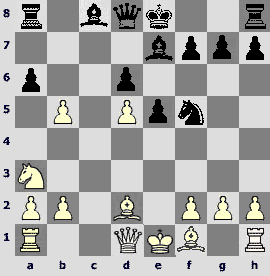
13...e4! Black idea is to prevent white bishop from getting to d3.
14.bxa6 0–0 15.Ґe2 Ґf6. Risky is15...e3?! 16.fxe3 (and in case of16.Ґxe3 ¤xe3 17.fxe3 Ґh4+ 18.g3 Ґg5 Black can count on equality at the very most, too many pawns have been given up). 16...Ґh4+ 17.g3 ¤xg3 18.hxg3 Ґxg3+ 19.ўf1 Јf6+ 20.Ґf3 Ґxa6+ 21.ўg1 Ґe5 22.Ґe4 Јg5+ (22...h6 23.¤c2) 23.Ґg2 Ґd3 (23...Ґxb2 24.Јc2) 24.¦h5 Јg6 25.¦xe5 dxe5 – position is sharp, but White most probably has an advantage.
16.¤c4 Ґxa6 17.0–0 ¤d4. Now simplifications are unavoidable. 17...Ґxc4 18.Ґxc4 Ґxb2 19.¦b1 leads to a more complex play.
18.¦c1 Ґb5 19.Ґc3 ¤xe2+ 20.Јxe2 ¦xa2 21.Јxe4 Ѕ–Ѕ
The following game is interesting for the theory of opening.
V.Anand (2779) – L.van Wely (2683) [B97]
1.e4 c5 2.¤f3 d6 3.d4 cxd4 4.¤xd4 ¤f6 5.¤c3 a6 6.Ґg5 e6 7.f4 Јb6 8.Јd2 Јxb2 9.¦b1 Јa3 10.e5 h6 11.Ґh4 dxe5 12.fxe5 ¤fd7 13.¤e4 Јxa2 14.¦d1 Јd5 15.Јe3 Јxe5 16.Ґe2 Ґc5 17.Ґg3 Ґxd4 18.¦xd4 Јa5+ 19.¦d2 0–0 20.Ґd6
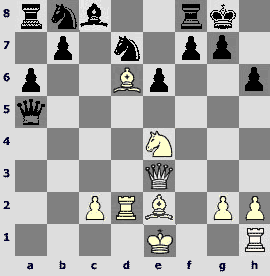
20...¤c6! A novelty, and a quite good one to all appearances. Anand himself in beginning of the tournament had played against Motylev 20...¦d8, and even won that game, but leaving the king without its last defender looks rather dangerous. Anand's now choosing this variation for White confirms this impression.
21.Ґxf8 ¤xf8 22.0–0. Black has three pawns for an exchange – not such a great material advantage, but then White has no attack and only a certain initiative.
22...Ґd7 23.¤d6 ¤e5 24.¤xb7 Јc7 25.¤d6 f6 26.c4 Ґc6 27.¦a1 ¤fd7 28.Јd4 a5 29.¤b5
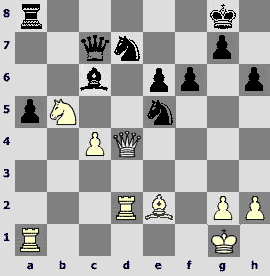
29...Јb6? Loek has been playing very well so far, but here he makes a serious mistake; the correct way is 29...Јb7 30.Ґf1 (to move repetition leads 30.¤d6 Јc7) 30...a4, and Black retains a defendable position.
30.Јxb6 ¤xb6 31.¦d6 ¤bd7 32.¤d4 Ґe4 33.¤xe6 a4 34.¤c7
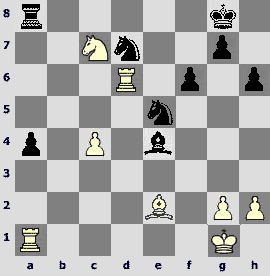
34...¦a5? The rook exchange is disastrous for Black, more tenacious is 34...¦a7 or 34...¦c8.
35.¦a6! ¦xa6 36.¤xa6 Ґc6 37.c5! Ґb7 38.¦c1 ¤c6 39.¤c7 ¤d4 40.Ґc4+ ўf8 41.¦d1 1–0
P.Svidler (2728) – V.Kramnik (2766) [C42]
Nothing noteworthy happened in this game.
1.e4 e5 2.¤f3 ¤f6 3.¤xe5 d6 4.¤f3 ¤xe4 5.d4 d5 6.Ґd3 Ґd6 7.0–0 0–0 8.c4 c6 9.¦e1 Ґf5 10.Јb3 Јd7 11.¤c3 ¤xc3 12.Ґxf5 Јxf5 13.bxc3 b6 14.cxd5 cxd5 15.Ґa3 Ґxa3 16.Јxa3 ¤c6 17.h3 Јd7 18.¤e5 ¤xe5 19.¦xe5 ¦ae8 20.¦ae1 ¦e6 21.¦xe6 Ѕ–Ѕ
L.Aronian (2744) – V.Topalov (2783) [A29]
1.c4 e5 2.¤c3 ¤f6 3.¤f3 ¤c6 4.g3 d5 5.cxd5 ¤xd5 6.Ґg2 ¤b6 7.0–0 Ґe7 8.¦b1 a5 9.d3 Ґe6 10.Ґe3 0–0 11.Ґxb6 cxb6 12.e3. A novelty, that had met with a strong specific rejoinder. Garry Kasparov in one of the display games played 12.Јa4 with the same idea – after¦fd1 and, possibly, e2-e3 to accomplish d3-d4.
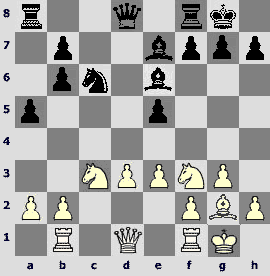
12...b5! An exchange of a double, immobilized on the dark square pawn is undoubtedly helpful.
13.¤xb5 Ґxa2 14.¦c1 a4! And another pawn leaves an unpleasant dark-colored square.
15.¤c3 Ґb3 16.Јe2 Ґe6 17.¦a1 a3 18.bxa3 ¦xa3 19.¦xa3 Ґxa3 20.¤b5 Ґe7 21.d4 Ґg4 22.h3 Ґxf3 23.Ґxf3 exd4 24.exd4 Ґf6 25.¦d1 Јb6 26.Јc4 ¦d8 27.ўg2 ¤xd4 28.¤xd4 ¦xd4 Ѕ–Ѕ
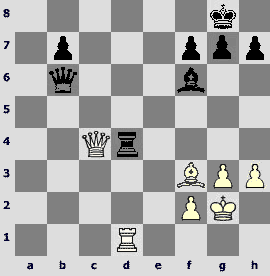
Quick draws due to the complete annihilation of material do happen even in the games of such uncompromising opponents. A clear-cut game, which surely left both players unsatisfied though, especially Levon, who at this moment had remained behind the leader.
R.Ponomariov (2723) – S.Kariakin (2678) [B90]
1.e4 c5 2.¤f3 d6 3.d4 cxd4 4.¤xd4 ¤f6 5.¤c3 a6 6.Ґe3 e5 7.¤b3 Ґe6 8.Јd2 Ґe7 9.0–0–0
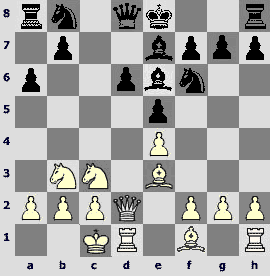
9...0–0?! Taking into account the move order chosen by White, who has done without f2-f3, Black should have played more intricately– 9...¤bd7!, in order after 10.f4 b5 to secure the c4-square for the bishop (in case of f4-f5).
10.f4 exf4?! [more interesting is 10...¤g4!?] 11.Ґxf4
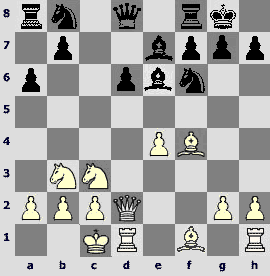
11...¤e8? Now Black's position becomes too passive. It was necessary to venture on11...¤c6!? 12.Ґxd6 (12.Ґe2 ¤e5 13.¤d4 lead with moves transposition to a well-known modification of Najdorf variation, beginning with 6.Ґe2. White's chances are a little better there, but he faces a complex play. Also is worth attention 12.h3!?, and if 12...¤h5, then 13.g3) 12...Ґg4 13.Ґxe7 (13.Ґe2 Ґxd6 14.Јxd6 leads only to equality) 13...Јxe7 14.¦e1 – Black has compensation for the pawn.
12.Ґe2 ¤c6 13.g4. White play is easy and simple. 13...Ґf6 14.g5 Ґe5 15.h4

The e8-knight and the f8-rook are "sealed off", the outcome is decided.
15...¦c8 16.ўb1 Јb6 17.¤d5 Ґxd5 18.exd5 Ґxf4 19.Јxf4 ¤e5 20.h5 Јd8 21.¤d4 Јd7 22.¤f5 b5 23.¦df1 ¤c7 24.Јd4 a5 25.Ґg4 Јd8 26.¦e1 ¦a8 27.h6 g6 28.¦xe5 dxe5 29.Јxe5 f6 30.¤e7+ ўf7 31.Јxf6+ ўe8 32.Јc6+ 1–0
D.Navara (2719) – A.Shirov (2715) [A07]
1.¤f3 ¤f6 2.g3 d5 3.Ґg2 c6 4.0–0 Ґg4 5.d3 ¤bd7 6.¤bd2 e5 7.e4 dxe4 8.dxe4 Ґc5 9.h3 Ґh5 10.Јe1 0–0 11.a4 ¤e8 12.¤h4 a5 13.¤b3 Ґb6 14.Ґe3 Ґxe3 15.Јxe3 ¤c7 16.¤f5 ¤e6 17.h4 Јc7 18.Ґh3 ¦fd8 19.ўh2 ¤f6 20.f3 c5 21.Јc3 b6
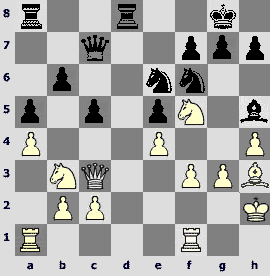
In the opening there was a tenacious struggle without any claim to an advantage on the part of White's, which is typical for the variation chosen by him. The similar development of the play could have been anticipated, but then out of the blue there follows
22.¦ad1? On the natural 22.¤e3 with a threat to trap the bishop there would have followed 22...¤d4 23.g4 Ґg6 24.h5 Ґxe4! 25.fxe4 ¤xe4 26.Јc4 ¤g5 with an attack. So there followed naturally
22...¦xd1 23.¦xd1
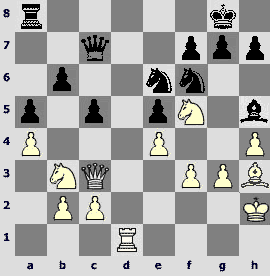
23...¤xe4, and White has lost the crucial central pawn. Alexey Shirov was irreproachable in utilizing his advantage.
24.Јe3 ¤f6 25.¦e1 ¦d8 26.g4
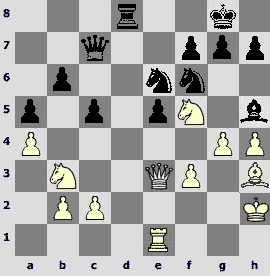
26...c4! 27.¤xa5 e4+ 28.ўh1 Ґg6 29.¤e7+ Јxe7 30.¤c6 Јc7 31.¤xd8 Јxd8 32.h5 ¤d5! A crucial move, which should have been anticipated.
33.Јf2 e3 34.Јh2 Ґxc2. Black queen is ready to get into the melee from the h4-square, so White resigns. 0–1
S.Tiviakov (2667) – A.Motylev (2647) [B10]
One of a few games in this tournament where Sergei Tiviakov has been trying to play for a win. He had played well, possessing the initiative, but still failed to cash on his advantage.
1.e4 c6 2.d3 d5 3.¤d2 g6 4.¤gf3 Ґg7 5.g3 e5 6.Ґg2 ¤e7 7.0–0 0–0 8.b4 a5 9.bxa5 Јxa5 10.Ґb2 Јc7 11.¦e1 d4 12.c3 dxc3 13.Ґxc3 c5 14.a4 ¤bc6 15.¤c4 Ґe6 16.Јb3 ¤d4 17.Ґxd4 cxd4 18.¦ec1 ¤c6 19.¦ab1 Ґh6 20.¦c2

20...¦a5. Alexander prevents the white queen from getting to b5, after which the white knight could have followed along the route c4-b6-d5, securing a stable advantage for White.
21.Јa3 Ґxc4. Black has no slightest wish to part with such a bishop, but it can't be helped.
22.¦xc4 ¦fa8 23.Јb3 ¦8a7
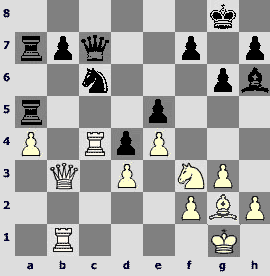
24.h4! A multi-purpose move, the play from the kingside begins. White secures the g5-square for the knight and is ready to weaken the black king by means of h4-h5.
24...Јc8! A very good defensive move – the queen heads for a8, depriving the white bishop from the h3-square in passing.
25.ўh2 Јa8 26.Ґh3 ¦xa4 27.¦xa4. The showy 27.¤xe5 ¤xe5 28.¦c8+ Јxc8 29.Ґxc8 ¤f3+ 30.ўg2 ¤d2 31.Јb6 ¤xb1 32.Јxb1 ¦a2 would have lead to a draw.
27...¦xa4 28.Јxb7 Јxb7 29.¦xb7 ¦a2 30.ўg1 ¦a1+ 31.ўg2 ¦a2 32.¤g5 ¦a7! With a series of precise moves Alexander manages to reduce White's advantage almost to a naught.
33.¦b6 ¦c7 34.Ґd7

34...¤d8. A "micro-inaccuracy". To a draw leads 34...¦xd7 35.¦xc6 Ґxg5 36.hxg5 ¦a7, getting the d3-pawn.
35.Ґg4 ¤b7?! Another inaccuracy, and a more serious one now. 35...ўg7! permits to consolidate position, and 36.¤f3 is not a danger(36.f4 ¦c3, and Black surely draws) 36...f6 37.h5 Ґc1.
36.¤f3 Ґg7 37.¤d2?! Stronger is 37.h5!, and Black would have to take into account the threat of h5-h6, as it looks totally risky and anti-positional to continue 37...gxh5?! 38.Ґxh5 f6 39.¤h4, and White gets a dangerous initiative.
37...h5 38.Ґd1 ¤c5. White has failed to transfer the bishop to a2-g8 diagonal.
39.Ґe2 ¦a7 40.¦b5 Ѕ–Ѕ
Round 10
S.Kariakin (2678) – V.Anand (2779) [B90]
1.e4 c5 2.¤f3 d6 3.d4 cxd4 4.¤xd4 ¤f6 5.¤c3 a6 6.Ґe3 e5 7.¤b3 Ґe6 8.Јd2 ¤bd7 9.0–0–0 b5 10.f3 Ґe7 11.g4 0–0 12.g5 b4 13.¤e2 ¤e8 14.h4 a5 15.ўb1 ¤b6 16.¤g3 a4 17.¤c1 d5 18.Ґxb6 Јxb6 19.exd5 ¦d8 20.Ґc4 ¤c7 21.dxe6 ¦xd2 22.exf7+ ўh8 23.¦xd2
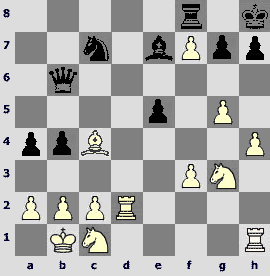
23...¤b5! The strongest move which has occurred in practice only once in a game of little-known players. Weaker is 23...Јc6 24.b3 ¤b5 25.Ґxb5 Јxb5 26.¤f5 ¦xf7 27.¤xe7 ¦xe7 28.¦d8+ ¦e8 29.¦hd1, and White retains a small pressure. Alexander Morozevich even managed to win this position for White.
24.Ґxb5. Admitting that 23...¤b5 chosen by Black is much stronger than 23...Јc6. More active is 24.¦d7, and after 24...¤a3+ 25.bxa3 bxa3+ 26.¤b3 Јb4 27.¤e4 Јxc4 28.¦xe7 axb3 29.axb3 Јd4 30.c3 Јd3+ 31.ўa2 Јe2+ (a draw also follows after 31...Јxf3 32.¦h2 g6 33.¤f6 ўg7 34.¤e8+ ўh8) 32.ўxa3 ¦a8+ 33.ўb4 ¦b8+ Black draws with perpetual check.
24...Јxb5 25.¤f5 ¦xf7 26.¤xe7 ¦xe7 27.¦d8+. It also occurred 27.¦e1 ўg8 28.¦d3 ¦f7 29.¦d8+ ¦f8 30.¦xf8+ ўxf8 31.¤d3 b3 32.¦e4, and it is hardly possible to avoid a draw (Schoen – Soltau, 2004).
27...¦e8 28.¦hd1

28...¦g8! 28...g6 permits to force a draw at once: 29.¦1d5 Јc6 30.¦5d6.
29.b3 a3. Only White has problems in this ending. 30.¦1d5. 30.¦8d5, not weakening the first rank, seems better, but White's position would not be enviable anyway because of the constant threats to the king.
30...Јf1 31.¦xg8+ ўxg8 32.¦xe5 Јxf3 33.¦c5 Јh1 34.¦c4 Јe1 35.¦f4
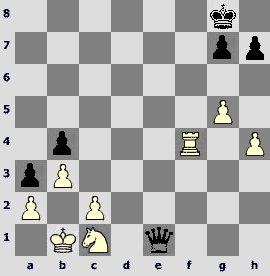
35...h5! 36.gxh6 gxh6 37.¦g4+ ўf7 38.¦f4+ ўg6 39.¦g4+ ўf5 40.¦c4 h5 41.¦c5+ ўg4 42.¦c4+ ўf3
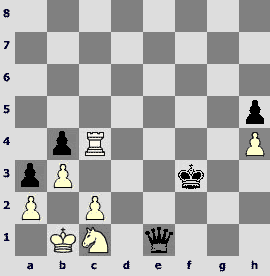
White is in zugzwang, any move leads to defeat.
43.¦d4 Јe5 44.c3 Јh2 45.¦d3+ ўe4 46.¦d4+ ўf5 47.¤d3 Јd2 48.¦d5+ ўf6 49.c4 Јd1+ 50.¤c1 Јg4 51.¦d2 Јxh4 52.¤d3 Јd4 53.ўc2 h4 54.¤xb4 Јb2+ 55.ўd1 Јb1+ 56.ўe2 Јe4+ 57.ўd1 h3 58.¤d3 Јh1+ 59.ўe2 h2 60.¤f2 Јg2 61.ўe3 ўe7 62.¦d5 h1Ј 63.¤xh1 Јxa2 0–1
S.Tiviakov (2667) – D.Navara (2719) [C66]
1.e4 e5 2.¤f3 ¤c6 3.Ґb5 ¤f6 4.d3 d6 5.0–0 Ґd7 6.¦e1 g6 7.Ґxc6. Surprise, surprise! Probably, Sergei was eager to define the position in the center as quickly as possible.
7...Ґxc6 8.c4 Ґg7 9.¤c3 0–0 10.d4 exd4. A timid reply, 10...¤h5 or 10...¤g4, retaining the pawn wedge on e5, looks much more interesting.
11.¤xd4
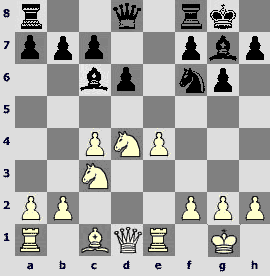
11...¤g4 A typical leap. 12.Јxg4. Risky is 12.¤xc6 Јh4, so White chooses a reliable way.
12...Ґxd4 13.Ґg5 Јd7 14.Јxd7 Ґxd7 15.¤d5 Ґc6. On15...Ґxb2 would follow not 16.Ґf6 Ґxf6 17.¤xf6+ ўg7 18.¤xd7 ¦fd8 19.¦ab1 b6, and the knight is trapped, but a simple 16.¦b1.
16.Ґf6 Ґxf6 17.¤xf6+ ўg7 18.¤d5. Black can either immediately transpose the game into a rook ending or defend the c7-pawn at first – anyway the draw is not far off, and so the players have decided not to waste each other's time. Ѕ–Ѕ
A.Shirov (2715) – R.Ponomariov (2723) [B90]
1.e4 c5 2.¤f3 d6 3.d4 cxd4 4.¤xd4 ¤f6 5.¤c3 a6 6.Ґe3 e5 7.¤b3 Ґe6 8.Јd2 ¤bd7 9.f3 b5 10.a4 b4 11.¤d5 Ґxd5 12.exd5 ¤b6 13.Ґxb6 Јxb6 14.a5 Јb7 15.Ґc4 Ґe7 16.¦a4 ¦b8 17.Јd3 ¦a8 18.Јd2 ¦b8 19.¤c1 Ґd8 20.b3 0–0 21.¤a2 e4 22.¤xb4 ¦e8
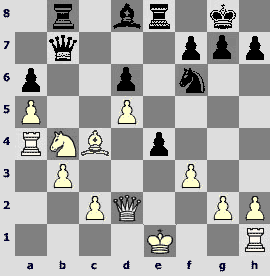
23.ўd1. A novelty, the move is typical for this variation.
23...e3 24.Јc3 e2+ 25.Ґxe2 ¤xd5 26.¤xd5 Јxd5+. As a result of forced operation White is a pawn up, but Black has a nice enough compensation by way of play using dark squares and possessing the e-file
27.Ґd3 Ґf6 28.Јc4 Јg5 29.Јg4 Јe3 30.Јf5
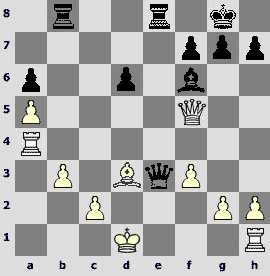
30...g6! 31.Јf4. Loses 31.Јxf6 ¦xb3 32.cxb3 Јxd3+ 33.ўc1 Јxb3.

31...Ґc3! Ruslan demonstrates a clear-cut way to draw, to play for win 31...Јe7 would have been a terrible risk – there are no direct threats, and he is still a pawn down; more than that, there is a tasty morsel on a6.
32.Јxe3 ¦xe3 33.¦e4 ¦e8 34.¦xe3 ¦xe3 35.Ґxa6 Ґxa5 36.ўc1 ўf8 37.ўb2 d5 38.ўa3 Ґc3 39.b4 ўe7 40.ўa4 ўd6 41.¦b1

41...¦e1. The main thing is not to forget to exchange rooks for all that. As Black has already managed to bring his king to the center, White has not a single chance to win in the opposite colored bishop ending.
42.¦xe1 Ґxe1 43.ўb3 f5 44.c3 h5 45.Ґb5 g5 46.ўc2 f4 47.ўd3 h4 Ѕ–Ѕ
V.Topalov (2783) – M.Carlsen (2690) [D38]
1.d4 ¤f6 2.c4 e6 3.¤f3 d5 4.¤c3 Ґb4 5.cxd5 exd5 6.Ґg5 0–0 7.e3 c5 8.dxc5 ¤bd7 9.¦c1 Јa5
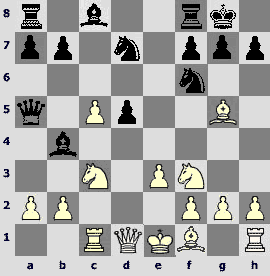
10.a3!! A real opening bomb! I guess Veselin Topalov has secured the "Chess Informant" Prize for best novelty for himself. It is well known, that after 10.¤d2 b6! Black has no problems at all.
10...Ґxc3+ 11.¦xc3 ¤e4 12.b4 ¤xc3 13.Јa1. And here is a theoretical substantiation for the Black's novelty – they have a whole lot of positional advantages for the exchange, Black's position is worse.
13...Јa4 14.Јxc3
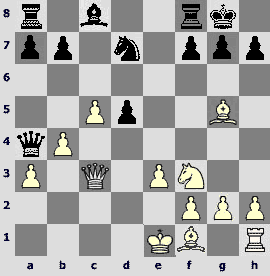
14...a5? To my mind, the only correct move is 14...¤b8! preparing the bishop's move to g4 and knight's lunge to c6, and at the same time clearing the way home to e8 for the queen.
15.b5
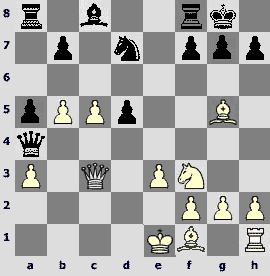
15...¤xc5? Incorrect; although the black position is already grave, still 15...¦e8, and then ¤d7-f8, is more tenacious.
16.Јxc5 Ґe6 17.Јc1 ¦fc8 18.Јa1 Јc2 19.Ґe2 Јc1+ 20.Јxc1 ¦xc1+ 21.Ґd1 ¦a1 22.a4 ¦c8 23.¤d4 ¦c4 24.0–0 f6 25.Ґf4 Ґf7 26.h4 1–0
T.Radjabov (2729) – P.Svidler (2728) [B41]
No one has turned off the drawish path in this game. All the moves are well known in theory and have already occurred in Peter's game against Vladimir Kramnik. Peter had lost then due to a blunder, which he wasn't going to repeat now. Having realized it, Teimour Radjabov offered a draw right away.
1.e4 c5 2.¤f3 e6 3.d4 cxd4 4.¤xd4 a6 5.c4 ¤f6 6.¤c3 Ґb4 7.Ґd3 ¤c6 8.a3 Ґxc3+ 9.bxc3 ¤e5 10.0–0 d6 11.f4 ¤xd3 12.Јxd3 e5 13.fxe5 dxe5 14.Ґg5 h6 15.Ґh4 exd4 16.e5 dxc3 17.Јxd8+ ўxd8 18.exf6 g5 19.Ґg3 Ѕ–Ѕ
A.Motylev (2647) – V.Kramnik (2766) [C42]
1.e4 e5 2.¤f3 ¤f6 3.¤xe5 d6 4.¤f3 ¤xe4 5.¤c3 ¤xc3 6.dxc3 Ґe7 7.Ґe3 0–0 8.h4!? An interesting opening idea. Usually White immediately moves his queen to d2, but Alexander is going to "throw" his knight to g5 and then watch if the queen is allowed to take a more active d3-square.
8...¤d7 9.¤g5 ¤e5 10.Јd2. Everything turns out unusual – the black knight has leaped to e5 a bit early, and the white one has found itself on g5 unnecessarily.
10...c6 11.0–0–0 Јa5 12.a3

12...f6! In case of12...h6 the knight would have been left under attack, but now in has to retreat.
13.¤f3 b5. After 13...Ґe6 Vladimir surely wouldn't have liked 14.¤d4.
14.c4 Јxd2+ 15.¤xd2 a6 16.f4 ¤g4 17.Ґg1
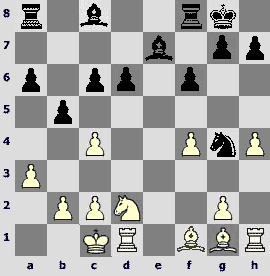
White rook is ready to come into a play over h3. White's chances are better, but the position is rather complex, 17...¤h6!? seems the best move for Black to me, as it prevents the rook from getting to h3. Ѕ–Ѕ
L. van Wely (2683) – L.Aronian (2744) [D38]
1.d4 ¤f6 2.c4 e6 3.¤f3 d5 4.¤c3 Ґb4 5.Ґg5 ¤bd7 6.cxd5 exd5 7.Јc2 c5 8.a3 Ґxc3+ 9.Јxc3 h6 10.Јe3+ Јe7 11.Јxe7+ ўxe7 12.Ґf4 b6 13.dxc5 bxc5 14.b4
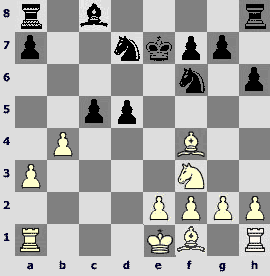
14...a5. Gabriel Sargissian had recently played against Loek14...¤e4, and after 15.e3 a5 16.b5 Ґb7 17.a4? g5 even obtained an advantage, which he, in fact, failed to convert into a win. White's play can be strengthened by 15.¤d2!?, and a small advantage is White's.
15.bxc5 ¤xc5 16.¤d4 Ґd7 17.f3. White stands better, but black pieces seem active enough for a draw.
17...¦hc8
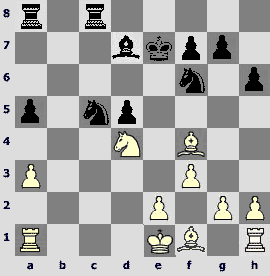
18.g4! Surely not18.e3 because of18...¤h5.
18...¤e8 19.h4 ¤d6 20.¦d1 ¤a4 21.e3 ¦ab8 22.¦h2 ¤b2 23.¦a1 ¦b6 24.¦d2 ¤bc4 25.¦c2 ¤b5 26.¤xb5 ¦xb5
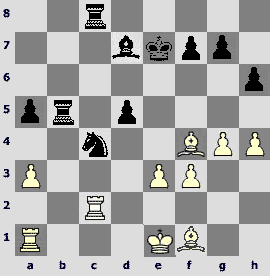
27.e4! ¦b3 28.Ґe2 ¤xa3?! The draw could be made safely after 28...¦xa3 29.¦xa3 ¤xa3 30.¦xc8 Ґxc8 31.exd5 Ґb7 32.d6+ ўd7.
29.¦xc8 Ґxc8 30.Ґd1 ¦xf3?? A blunder! After 30...¦d3 31.exd5 Ґb7 32.d6+ ўd8 black position looks dangerous, but still he is able to hold his own.
31.Ґc1 ¦h3 32.Ґxa3+ ўe6 33.exd5+ ўxd5 34.Ґf8 ¦xh4 35.¦xa5+ ўe6 36.Ґxg7 ¦h1+ 37.ўd2 f6
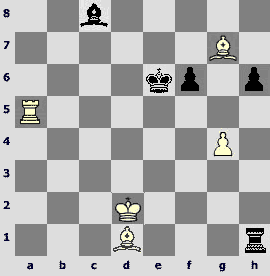
And here Loek van Wely accomplishes the task of not winning the game without dropping anythingat one stroke.
38.¦h5??

38...¦xd1+!! A most unexpected and equally beautiful move. 39.ўxd1 ўf7 40.¦xh6 Ґxg4+ Ѕ–Ѕ
